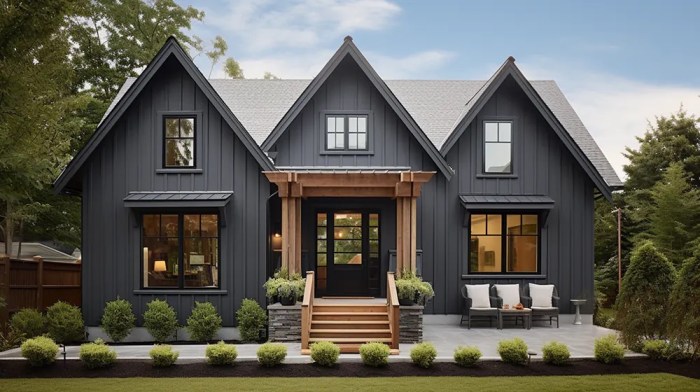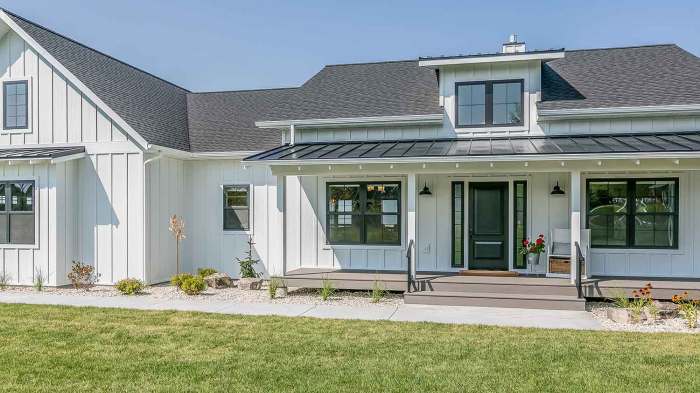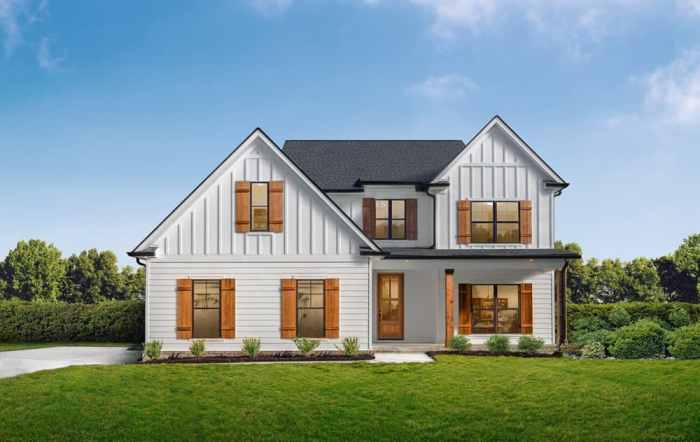Exploring the world of board and batten home exteriors unveils a rich tapestry of history, design, and maintenance. This guide aims to shed light on the allure and practicality of this architectural style, offering valuable insights for homeowners and enthusiasts alike.
Delve into the nuances of board and batten siding, from its humble origins to its modern-day appeal. Discover the steps for installation, maintenance tips, and design ideas to elevate your home's exterior aesthetic.
Introduction to Board and Batten Home Exterior

Board and batten siding is a style of exterior cladding that features alternating wide boards and narrow strips, known as battens, creating a distinctive look.
This architectural style has a rich historical significance, dating back to the medieval times when it was used to construct barns and other agricultural buildings. Over time, it transitioned to residential homes, particularly in North America, where it became popular during the Victorian era.
Visual Appeal of Board and Batten Homes
Board and batten homes are known for their charming and rustic appearance. The vertical lines created by the battens add visual interest and texture to the exterior, giving the home a unique character. Additionally, the deep shadows and pronounced seams created by this style of siding can evoke a sense of nostalgia and coziness.
Installation of Board and Batten Siding
Board and batten siding is a popular choice for homeowners looking to add a rustic and charming look to their homes. The installation process involves a few key steps that need to be followed carefully to ensure a successful outcome.
Steps Involved in Installing Board and Batten Siding
- Prepare the Wall Surface: Before installing the siding, make sure the wall surface is clean, smooth, and in good condition. Any repairs or replacements should be done beforehand.
- Measure and Cut the Boards: Measure the dimensions of the boards accurately and cut them to size using a saw. Ensure precise cuts for a proper fit.
- Install the Boards: Start by installing the boards vertically, leaving a small gap between each board for expansion. Secure the boards to the wall using nails or screws.
- Add Battens: Once the boards are in place, add the battens horizontally over the seams to cover them and create a visually appealing pattern.
- Finish and Paint: Finally, finish the installation by painting or staining the siding to protect it from the elements and enhance its aesthetic appeal.
Comparison of Different Materials for Board and Batten Siding
- Wood: Traditional and versatile option, but requires regular maintenance to prevent rot and decay.
- Vinyl: Low maintenance and durable, but may not offer the same authentic look as wood.
- Fiber Cement: Resistant to rot, insects, and fire, but can be heavier and more challenging to install.
Tips for DIY Installation versus Professional Installation
- DIY Installation: Suitable for those with some experience in carpentry and home improvement projects. Make sure to follow manufacturer guidelines and take your time to ensure a proper installation.
- Professional Installation: Recommended for complex projects or if you lack the necessary skills. Hiring a professional ensures a faster and more precise installation, with guaranteed results.
Maintenance of Board and Batten Homes

Proper maintenance is essential to ensure the longevity and aesthetics of board and batten exteriors. By following some key practices, you can prevent issues like rot or insect damage and keep your siding looking great for years to come.
Maintenance Requirements for Board and Batten Exteriors
Board and batten siding should be inspected regularly for any signs of damage, such as cracks, peeling paint, or moisture penetration. It is important to address any issues promptly to prevent further damage.
- Regularly clean the siding to remove dirt, grime, and mold that can accumulate over time. Use a mild detergent and a soft brush or sponge to avoid damaging the wood.
- Inspect the caulking and sealant around windows, doors, and seams to ensure they are intact and in good condition. Replace any deteriorating caulking to prevent water infiltration.
- Repaint or re-stain the siding every few years to protect it from the elements and maintain its appearance. Choose high-quality paint or stain products for long-lasting results.
Preventing Issues like Rot or Insect Damage
- Ensure proper ventilation behind the siding to prevent moisture buildup, which can lead to rot. Adequate ventilation will help the wood dry out quickly and prevent fungal growth.
- Trim back vegetation around the house to prevent contact with the siding, as plants can trap moisture and create an ideal environment for insects and rot to thrive.
- Regularly inspect the exterior of your home for any signs of insect activity, such as holes in the wood or sawdust piles, and take action immediately to prevent further damage.
Best Practices for Cleaning and Preserving Board and Batten Siding
Proper cleaning and maintenance can significantly extend the lifespan of board and batten siding. Here are some best practices to keep your siding looking its best:
- Avoid using pressure washers, as they can damage the wood and force water behind the siding. Instead, opt for gentle cleaning methods using a garden hose or a soft brush.
- Regularly remove dirt and debris from the siding to prevent staining and mold growth. This can be done with a simple mixture of water and mild detergent.
- Consider applying a protective sealant to the siding every few years to enhance its durability and resistance to the elements. Consult with a professional for the best sealant options for your specific siding material.
Design Ideas for Board and Batten Exteriors
When it comes to designing board and batten exteriors, there are various modern trends and color schemes that can enhance the overall look of your home. Additionally, certain architectural styles are known to pair exceptionally well with board and batten siding, creating a unique and charming aesthetic.
Modern Design Trends
- Utilizing contrasting colors to create a visually striking facade.
- Adding metal accents or trim for a contemporary touch.
- Incorporating large windows and minimalistic landscaping to complement the clean lines of the board and batten siding.
Enhancing Look with Color Schemes
- Opting for a monochromatic color scheme for a sleek and modern appearance.
- Choosing bold, vibrant colors to make a statement and add personality to the exterior.
- Using natural wood tones for a warm and inviting feel.
Architectural Styles that Pair Well
- Craftsman: The simple and sturdy design of Craftsman homes complements the rustic charm of board and batten siding.
- Farmhouse: Board and batten siding is a classic choice for Farmhouse-style homes, adding to their traditional and cozy appeal.
- Cape Cod: The clean lines and symmetrical design of Cape Cod homes are accentuated by the verticality of board and batten siding.
Wrap-Up

In conclusion, board and batten homes stand as timeless icons of architectural charm and durability. Embrace the beauty of this classic style while implementing best practices for upkeep and enhancement. Let your home's exterior tell a story of elegance and resilience with board and batten siding.
Question Bank
What is board and batten siding?
Board and batten siding is a style of exterior cladding that features alternating wide boards (boards) and narrow strips (battens) to create a visually appealing look.
How can I prevent rot or insect damage on board and batten exteriors?
To prevent issues like rot or insect damage, ensure proper sealing, regular inspections, and prompt repairs of any damaged areas on the siding.
What are some popular color schemes for board and batten homes?
Popular color schemes for board and batten homes include classic combinations like white siding with black battens, or more modern choices like gray siding with white battens.







